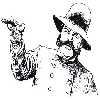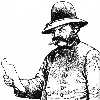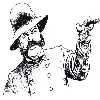The Great War
I tried to steer clear of the Great War for a long time, since although I had been inspired at an early age by Alistair Horne's 'The Price of Glory', Correlli Barnett's 'Swordbearer's', John Terraine's TV series - and indeed the poems of Wilfred Owen - the message conveyed by all of these was inevitably a very negative one. Beyond them I knew that it was the Great War, above all wars, which gave military history a bad name among the wider public. It seemed to represent the total nadir of any 'art' of war there might be, while the war memorials in every town or village stood as a permanent reminder of the horrific human cost.
As I found out more about the tactics of other wars, however, it gradually came home to me that in tactical terms the Great War was very important indeed, since it was the key turning point between 'old' and 'new' methods of fighting. It was the first war in which all the new weaponry of the later nineteenth century was properly used in practice. The Great War was 'the first modern war' not because it saw extensive use of trenches (a technology that had already been well known to Vauban - and even to Julius Caesar), but because it used High Explosives. Yet few convincing or readily-accessible books seemed to describe the way tactics had been adapted to the newly high-explosive world. This looked like an interesting subject for me to study...

|
The result was my 'Battle Tactics on the Western Front 1916-18' (Yale University Press, London 1994: ISBN 0 300 05910 8. A slightly revised paperback edition appeared in 1996: ISBN 0 300 06663 5). This book makes a lengthy analysis of the way that British tactics improved markedly after the first day of the Somme, leading to war-winning virtuosity by August 1918. The popular stereotype of British assault techniques is one of massed lines of unsupported infantry being mown down by the thousand on 1st July 1916; but what is less well known is that significant tactical reform was already evident by 14th July. The British invented their own version of 'storm troop tactics' at least as fast as the Germans did, and issued their official manual for modern infantry platoon attacks in February 1917.
In the Lewis Gun the British had a better light machine gun than the Germans, and in the Stokes Mortar they had one of the truly classic weapons of the twentieth century. Admittedly they rejected the concept of infantry cannons, made little progress with flamethrowers, and suffered a definite failure with the laughable 'pipe pusher' underground assault system. Yet they led the world with the tank and also, of still greater significance, in all the techniques of artillery.
|
By the end of 1917 the Royal Artillery's combination of creeping barrages for close support, and accurate predicted fire for long range counter-battery work, gave their art of attack a major advantage over their opponents. In the spring of 1918 the British art of defence turned out to be woefully defective - but in August the offensive momentum was regained in such a way that the Germans could find no real answer. All this is missed by the many authors who concentrate only upon the 'butchery and bungling' of the first half of the war, and who think it is somehow 'spoiling the story' to report the many things that the British got right.
'British Fighting Methods on the Western Front' (Collected essays by eight scholars edited by Paddy Griffith, and published by Frank Cass, London 1996: ISBN 0 7146 3495 6: also later reprints & paperback editions)
Apart from my own introductory essay, the book contains chapters
on:
|
Artillery by Jonathan Bailey
British Divisions in the Hundred Days by Peter Simkins
Military Police by Gary Sheffield
Military Medicine by Geoffrey Noon
Armour by Paul Harris
Cavalry & Breakthrough Doctrine by Stephen Badsey,
The 'SHLM' project to make an in-depth study of the history of every BEF
Division, by John Lee
'British Fighting Methods' brings together the fruits of modern research in all the above fields, and it is remarkable to find that all the authors share a similar view: the British Expeditionary Force may have started its war in a state of tactical naivety, but by 1918 it had made vast improvements and had invented more than its fair share of what would become the standard techniques of combat through the remainder of the twentieth century.
|

|
On similar themes I contributed a chapter on 'The tactical problem: infantry, artillery and the salient' to Peter H Liddle's collection of essays on 'Passchendaele in Perspective: the third battle of Ypres' (Leo Cooper, London 1997: ISBN 0 85052 588 8). This chapter caused a few eyebrows to rise, since I claim that the British technically 'won' the battle, despite their many obvious difficulties and failures. I base this claim on the repeated successes of the British artillery in destroying enemy counter-attacks, regardless of whatever tactical system the Germans, in desperation, tried to apply. It is, incidentally, a finding that is confirmed from German sources reported elsewhere in the same volume.
|
|

|
Surviving section of trench at Sanctuary Wood, Ypres
|
'With the Rank and Pay of a Sapper the 216th (Nuneaton) Army Troops company of the Royal Engineers in the Great War' by James Sambrook (Paddy Griffith Associates, 1998: ISBN 0 9521488 3 8). In its own way this excellent account of one engineer company's experiences confirms the general story of increasing efficiency and technological expertise throughout the war. In this case there is extensive discussion of the new series of steel girder bridges, which revolutionised the crossing of water obstacles.





